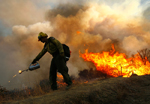Wildfire
Back to Hazards Directory

Palm Beach County is home to over a million residents who enjoy the County’s beautiful scenery and warm climate. But few people realize that these qualities also create severe wildfire conditions. Each year, thousands of acres of wildland in Florida and many homes are destroyed by fires that can erupt at any time of the year from a variety of causes, including arson, lightning and debris burning. Adding to the fire hazard is the growing number of people living in new communities built in areas that were once wildland. This growth places even greater pressure on the state's wildland firefighters. As a result of this growth, fire protection becomes everyone's responsibility.
Before a Fire: - Create a 30 to 50 foot safety zone around your home.
- Rake leaves, and clean up dead limbs and twigs.
- Clear away all flammable vegetation.
- Remove leaves and rubbish from under structures.
- Thin a 15 foot space between tree crowns, and remove limbs within 15 feet of the ground.
- Remove dead branches that extend over the roof.
- Prune tree branches and shrubs within 15 feet of a stovepipe or chimney outlet.
- Ask the power company to clear branches from power lines. Do
NOT attempt to do it yourself.
- Remove vines from the walls of the home.
- Mow grass regularly.
Clear a 10 foot area around propane tanks and the barbecue. Place a screen over your barbeque grill
use non-flammable material with mesh no coarser than one-quarter inch. - Regularly dispose of newspapers and rubbish in an approved manner.
- Follow local burning regulations.
Store gasoline, oily rags and other flammable materials only in approved safety containers. Place containers
in a safe location away from the base of buildings. - Install smoke alarms, and replace batteries twice a year at Daylight Savings Time, or sooner if necessary.
Place fire extinguishers in a visible and accessible location such as your kitchen and / or garage. Replace them
if they lose their charge or have been used. - Learn to use fire extinguishers - contact Palm Beach County Fire-Rescue at
561-616-7000 for more information.
- Plan your escape ahead of time.
- Get prepared for a fire emergency by drawing a floor plan of your home and marking two ways out of each room.
- Review the plan with household members and practice your escape routes.
- Decide on a safe place outside your home where everyone will meet after evacuating.
Additional Safety Tips: - Even in urban areas, wildfires (grass, trees and brush) can occur.
- Keep a collapsible ladder on each upper floor of your home.
- By practicing fire safety both inside and outside of your home, you and your neighbors can make your whole neighborhood safer.
- Keep matches and lighters out of sight. Keep these items locked up and out of the reach of children. Teach young children to tell you if they find these items.
- Keep a whistle in each bedroom to awaken household members in case of a fire.
- Ensure that any security bars on windows can be opened from the inside.
- For outside fire safety, make sure your gutters are clear of leaves and pine needles.
If Trapped Indoors by Fire: - Call 9-1-1 from a safe location.
- Remain Calm.
- Do
NOT run.
- Never use elevators - smoke may fill elevator cars or shafts.
- Elevator doors can open onto a floor that is on fire or full of smoke and water can enter the elevator controls stranding the occupants in that elevator car.
- Do not break windows - oxygen feeds fires.
- If an exit from a room is blocked, wet towels and jam them into the cracks of doors to prevent smoke from entering.
- Do not assist firefighting personnel unless asked to do so.
- Do not be a spectator - head away from the problem area to a designated safe refuge. Remain in this area until instructed to return or relocate. Go to the meeting space that is designated in your family disaster plan.
- Never re-enter a burning building.
- Notify firefighters of missing or stranded people or pets.
At Work or School: - Learn the evacuation plan.
- Evacuate when instructed to do so, using the quickest route out of the building.
- Evacuation routes should minimize exposure to hazards.
- Close windows, turn off lights, and close (but do not lock) doors.
- Keep to the right, grasp available handrails, walk, keep silent, and if the assigned exit is not usable, head towards the next nearest exit.
- Account for everyone
- If you are trapped in a burning building, stay near a window and close to the floor.
- If possible, signal for help.
|